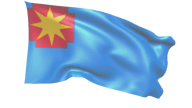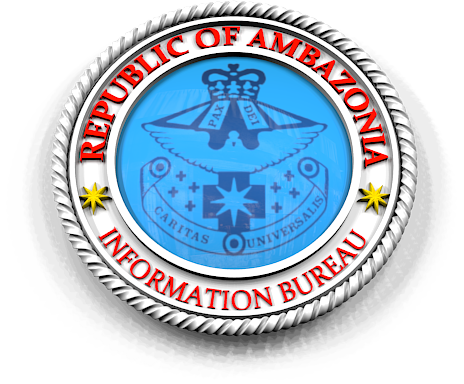In 1884 The Ambas Bay Colony with capital at Victoria was founded by Alfred Saker of English Baptist Missionary Society. The territory was ceded to Germany in 1887 after Germany had established the protectorate of Kamerun in July 1884. In November 1911, Kamerun was augmented by a cession of 270,00 sq. km of land from French Equatorial Africa (new region is named NeuKamerun-Ost & NeuKamerun-Süd).
In 1916 the Armies of France, Britain and Belgium jointly defeated Germany in the Kamerun and took over the territory, sharing it between France and Britain. The arrangement was made law by the Anglo-French Treaty of that same year and formalized in the Treaty of Versailles on 28 June 1919. France which occupied 80 percent of Kamerun immediately reunited the 270,000 sq. km. of land she had ceded to Germany in November 1911 back to French Equatorial Africa; while her remaining portion of Kamerun was christened French Cameroun. Britain on the other hand which contended itself with 20 percent of Kamerun named it British Cameroons.
Following the Treaty of Versailles, British Cameroons and French Cameroun became League of Nations Mandated territories in 1922, and then United Nations Trust Territories in 1946.
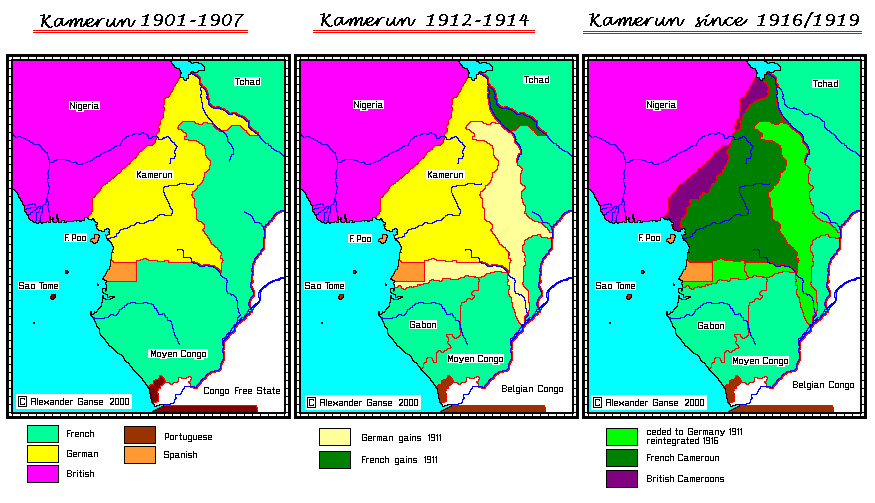
Britain, for administrative convenience, further divided British Cameroons into Northern British Cameroons & Southern British Cameroons. Northern British Cameroons was administered as part of Northern Nigeria while Southern British Cameroons was administered as part of Southern Nigeria. By the British Order in Council of 26 June 1923, Southern British Cameroons became a distinct territory from the Northern British Cameroons within the international trusteeship system, and a unit of self-determination. (See colonial Africa)
According to Article 76 (b) of The United Nations Charter, the basic objectives of the trusteeship system, was to promote the political, economic, social, and educational advancement of the inhabitants of the trust territories, and their progressive development towards self-government or independence………..
In 1954, Southern British Cameroons became a self-governing territory following her declaration of benevolent neutrality in the Nigerian Eastern House of Assembly. It had a legislature, Judiciary, House of Chiefs, and a prime minister (Dr. EML Endeley) who was also the Head of Government. In 1959, multiparty elections were held and the opposition candidate, Dr. John Ngu Foncha became the Prime Minister following a peaceful transfer of power, something that has not happened in French Cameroun and many other African Countries to this date.
When it came to decolonization, that is, granting self-government or independence to the Trust Territories, the United Nations made several blunders concerning British Cameroons. In the case of Southern British Cameroons, the United Kingdom carried out what analysts say is the most sophisticated slave trade deal under the cover United Nations, i.e., Southern British Cameroons was sold to France for a meager sum of 20,000,000 pounds which the British had invested in the Common wealth development corporation (CDC) according to British declassified documents.
Thus, while French Cameroun became independent as Republic of Cameroun on 1 January 1960, a plebiscite was forced on the people of British Cameroons in February 1961 to choose whether they wanted to achieve independence by joining the already independent Republic of Cameroon or joining the Federal Republic of Nigeria (Nigeria had independence on 1 October 1960). This was in violation of UN General Assembly Resolution 1514 of 14 December 1960 which affirmed that independence was the inherent and inalienable right of all colonies and trust territories as a guarantee for the enjoyment of their complete freedom. Since the plebiscite was conducted separately between the Northern & Southern British Cameroons, the people of Northern British Cameroons voted overwhelmingly to remain part of Nigeria while the majority of the people of Southern Cameroons voted to achieve independence by joining the Republic of Cameroun in a loose confederation. (See The Two Alternatives Part 2 -Republic of Cameroon and Southern Cameroons)
It should be noted that France and all independent French-speaking countries of West and Central Africa (including Republic of Cameroun itself) all voted against UN General Assembly resolution 1608(XV) on unification between Republic of Cameroun and Southern British Cameroons on April 21, 1961. In spite of this opposition from France and Republic of Cameroun itself, the resolution was adopted by the UN General Assembly.
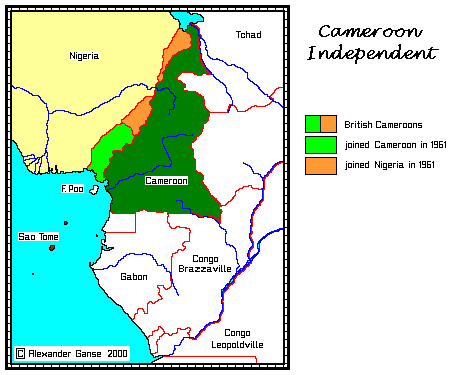 |
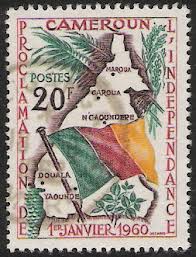 |
Since then, the fate of the Southern British Cameroons and the UN Resolution 1608(XV) of 21 April 1961 has been in violation by Republic of Cameroun, France, Britain and the United Nations itself now for forty years. (See Breach of International Obligations by Justice Muluh Mbuh) Paragraph 5 of UN Resolution 1608(XV) demanded that the contracting parties, that is Republic of Cameroun, Government of Southern British Cameroons, Britain and France should convene urgent discussions, which would be supervised by the United Nations Trusteeship Council, to ensure that an agreement of the Cameroon Federation was reached before the termination of the Trusteeship of the Southern British Cameroons.
The discussions which were held in Foumban (French Cameroun) from 17 – 21 July 1961 were to draw up a charter for the running of a two-State system within the federal political arrangement (See The Two Alternatives Part 2). These discussions were neither attended by UN Representatives nor by Britain leaving the Southern Cameroons at the mercy of crude French Cameroun politicians and French Technical Advisers; and France, eager to maintain treaties it had signed with French Cameroun at independence which rendered French Cameroun’s independent null and void (since France controlled Cameroun’s defense, economy, currency, imports and exports, etc.), co-opted the Southern Cameroons into the Republic of Cameroun. No union agreement was produced and consequently, no document was presented either to the National Assembly of Republic of Cameroun or to the Southern British Cameroons House of Assembly for ratification on the union between Republic of Cameroun and Southern British Cameroons. However, President Ahidjo unilaterally proclaimed into being the Federal Republic of Cameroon; Cameroon army marched into Southern British Cameroons on 30 September 1961 and the two states simply celebrated unification on 1st October 1961. Southern British Cameroons was henceforth called West Cameroon while Republic of Cameroun was called East Cameroon.
Article 102(1) of Charter of the United Nations states inter alia: “Every treaty and every international agreement entered into by any Member of the United Nations after the present Charter comes into force shall as soon as possible be registered with the Secretariat and published by it.” Therefore, the Federal republic of Cameroon was an illegal country because no treaty was ever signed between Ahidjo & Foncha uniting the two countries and no treaty of union between Southern British Cameroons and Republic of Cameroun has ever been deposited at the UN according to article 102(1) of Charter of the UN.
Even with this illegal arrangement, article 47(1) of the Constitution of the Federal Republic of Cameroon (a modified version of the Constitution of the Republic of Cameroun) stated inter alia, that: “No bill to amend the Constitution may be introduced if it tend to impair the unity and integrity of the Federation”. But Ahidjo, the President of the Federal Republic, moved to abolish the federation as early as 1966. Whereas John Ngu Foncha and Augustine Ngum Jua, leaning on article 47 of the Federal Constitution objected, Solomon Tandeng Muna took the opposite direction. And by a presidential decree of 1968, Ahidjo replaced Foncha & Jua with the colluding Muna; who now doubled as the Vice President of the Federation, and the Prime Minister of the Federated State of West Cameroon with residence in Buea. Four years later, on 20 May 1972, Ahidjo in violation of the said article 47 of the Federal constitution stage-managed a referendum which led to the complete dismantling of the federal structures in favor of a unitary state system; thereby transforming the ccountry into the United Republic of Cameroon. Southern British Cameroons which was already divided into six regions (Mamfe, Kumba, Victoria, Bamenda, Wum, Nkambe) was then made into South West & North West provinces of Cameroon; while East Cameroon was divided into Northern, Western, Littoral, Central South and Eastern provinces of Cameroon.
In 1984, by Law No 84/1 of 4 February 1984, Paul Biya committed high treason by seceding The Republic of Cameroun from the now illegal United Republic of Cameroon. By doing this, he revert the name of the country back to the Republic of Cameroun, the name by which French Cameroun gained independence on 1 January 1960. He went on to further divide East Cameroon (Republic of Cameroun) into Far North, North, Adamawa, West, Littoral, East, Centre, and South Provinces.
On 20 March 1985, Fon Fongum Gorji-Dinka, the first president of the Cameroon Bar Association and also a QC; CC; & ACP challenged Law 84/01 by publishing a pamphlet titled THE NEW SOCIAL ORDER. This pamphlet denounced what Fon Dinka saw as the gross mismanagement of Cameroon, dwelling particularly on the Southern Cameroons problem. In Dinka's terms, Republic of Cameroun had annexed the Southern Cameroons; and he advocated for the creation of a Southern Cameroons state to be called Ambazonia. The name Ambazonia (the zone or hinterlands of Ambas Bay) was chosen so as not to confuse Sothern British Cameroons with South Province of Cameroun; or West Cameroon with the West province of Cameroun. The New Social Order, predictably, provoked the fury of the Biya regime, and Fon Dinka sought refuge at the British Embassy.
On 5 May 1985, Fon Dinka wrote An Open Letter to L’etat Major of Cameroun asking them to defuse the timed bomb. This led to his arrest on 31 May 1985, and he was taken from Bamenda (Ambazonia) to Yaoundé, where he was detained in a wet and dirty cell without a bed, table or any sanitary facilities. He fell ill and was hospitalized. After having received information on plans to transfer him to a mental hospital, he escaped to the residence of the British Ambassador, who rejected his asylum request and handed him over to the police. On 9 June 1985, the author was re-detained at the headquarters of the Brigade Mixte Mobile (BMM), a paramilitary police force, where he initially shared a cell with 20 murder convicts.
While in jail, one Prison Guard questioned Fon Dinka whether his crime was one by which he could not work out some compromise with the government, lamenting that it was terrible for a country to see its highest lawyer behind bars! It is not certain whether the officer was sent by government or whether it was his own private initiative. It quickly occurred to Fon Dinka that this was an opportunity to ask and utilize a typewriter and make clear his intensions of not willing to give up simply on some compromise without actually having the government fully understand the implications of their actions, while correcting them.
The Prison Guard returned to government officials that morning boasting that the Anglo leader in jail has just told him he was willing to confess his crime against government and that he has demanded a typewriter to type out his confession. The Fon was to wear a smile when he returned with a typewriter the following morning. After a few days, Fon Dinka issued what the Prison Guard took to the Cameroun government as a confession; which turned out to be another pamphlet called The Rebellion of Ambazonia issued on 11 July 1985.
As a result of the physical and mental torture he was subjected to during detention, Fon Dinka suffered a stroke which paralyzed his left side. This provoked the so-called “Dinka riots”, whereupon schools closed for several weeks. On 11 November 1985, Parliament adopted a resolution calling for a National Conference to address the Ambazonian question. In response, President Biya accused the President of Parliament of leading a “pro-Dinka” parliamentary revolt against him; he had the author charged with high treason before a Military Tribunal, allegedly asking for the death penalty. The prosecution’s case collapsed in the absence of any legal provision which would have criminalized the author’s call on President Biya to comply with the Restoration Law by withdrawing from Ambazonia. On 3 February 1986, the author was acquitted of all charges and released from detention.
President Biya’s intention to appeal the judgment, after having ordered Fon Dinka to be rearrested, was frustrated because the law establishing the Military Tribunal did not provide for the possibility of appeal in cases involving high treason. Paul Biya then became furious and put Fon Dinka under house arrest between 7 February 1986 and 28 March 1988.
On 28 March 1988, Fon Dinka escaped to Nigeria and in 1995, he went to Great Britain, where he was recognized as a refugee and became a barrister.
On 10 October 1990, The Ambazonian Restoration Council made a Proclamation formalizing the independence of Ambazonia. It designated the spearhead of the liberation struggle HRH Fon Gorji-Dinka the Head of State of the Republic of Ambazonia. The proclamation with a case titled AMBAZONIA vs LA REPUPLIQUE DU CAMEROUN was filed at the United Nations with a charge that La Republique du Cameroun (Republic of Cameroun) is illegally occupying Ambazonia, and demanded UN action to terminate this illegal occupation of Ambazonia by Cameroun.

